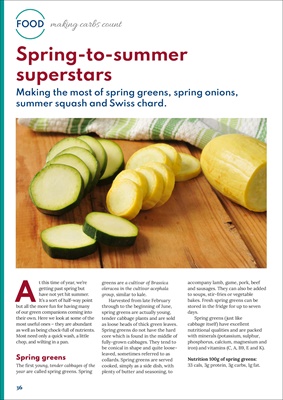
36
FOOD making carbs count
Spring-to-summer
superstars
Making the most of spring greens, spring onions,
summer squash and Swiss chard.
At this time of year, we're
getting past spring but
have not yet hit summer.
It's a sort of half-way point
but all the more fun for having many
of our green companions coming into
their own. Here we look at some of the
most useful ones - they are abundant
as well as being chock-full of nutrients.
Most need only a quick wash, a little
chop, and wilting in a pan.
Spring greens
The first young, tender cabbages of the
year are called spring greens. Spring
greens are a cultivar of Brassica
oleracea in the cultivar acephala
group, similar to kale.
Harvested from late February
through to the beginning of June,
spring greens are actually young,
tender cabbage plants and are sold
as loose heads of thick green leaves.
Spring greens do not have the hard
core which is found in the middle of
fully-grown cabbages. They tend to
be conical in shape and quite looseleaved,
sometimes referred to as
collards. Spring greens are served
cooked, simply as a side dish, with
plenty of butter and seasoning, to
accompany lamb, game, pork, beef
and sausages. They can also be added
to soups, stir-fries or vegetable
bakes. Fresh spring greens can be
stored in the fridge for up to seven
days.
Spring greens (just like
cabbage itself) have excellent
nutritional qualities and are packed
with minerals (potassium, sulphur,
phosphorus, calcium, magnesium and
iron) and vitamins (C, A, B9, E and K).
Nutrition 100g of spring greens:
33 cals, 3g protein, 3g carbs, 1g fat.